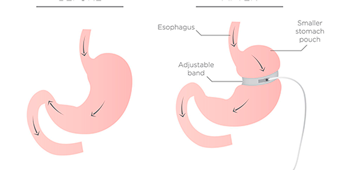Gastric sleeve surgery, also known as sleeve gastrectomy, is by far the most popular bariatric surgery worldwide. More than half of the weight loss surgeries performed around the world are gastric sleeve surgeries [1]. It is recognized, as other bariatric surgeries, to be a safe and effective treatment for obesity and its associated comorbidities.
How is the gastric sleeve done?
The gastric sleeve is a restrictive operation which reduces the size of the stomach and helps people with obesity lose weight. With a smaller stomach the person feels full much faster than before, which helps him or her make important and necessary lifestyle changes.
During surgery more than half of the stomach is removed. The new stomach is closed with special surgical staples, and given the shape of a banana or vertical sleeve. This is a non-reversible process.
Thanks to the advanced laparoscopic techniques that are used today, the patient’s recovery process is quite fast and the risks are minimal.
This procedure mainly induces weight loss by restricting the amount of food that you can eat, resulting in an overall metabolic improvement. However, hormonal changes that result from the surgery are also a very important part of the patient’s weight loss process.
Who are candidates for this procedure?
Patients with a Body Mass Index (BMI) higher than 40 are eligible for gastric sleeve surgery. Patients with a BMI higher than 35 might be eligible if they have two or more life threatening conditions that are associated with obesity, such as hypertension, type II diabetes, dyslipidemia or others.
Candidates for gastric sleeve surgery should also be willing to change their habits towards a healthier lifestyle, that includes exercise and a balanced diet.
Benefits of the gastric sleeve:
The gastric sleeve surgery is a very effective way to lose weight, but not only that. The procedure has proved to be effective in ameliorating and even resolving many different health conditions. It is also a more convenient surgery when compared with others, such as the gastric bypass or the duodenal switch, considering different factors.
Please keep reading to find out more about all the different benefits of the gastric sleeve surgery.
- It is done with laparoscopic techniques. Nowadays, most bariatric surgeries are done with a laparoscopic camera and utensils, which means that the patient doesn’t need to be cut open for his surgical intervention.
- This surgery involves no prosthetic material nor surgical maintenance, like it happens with the gastric band and the intragastric balloon.
- The surgical intervention takes less than an hour to complete and the post-operative stay at the hospital or clinic is only one night for most patients.
- Most patients can expect a fast recovery. Patients that receive gastric sleeve surgery need to rest at least 3 weeks after their procedure. After this time, they can go back to their normal activities, with proper care and compliance to their post-operative diet.
- Weight loss is also accomplished very fast. Patients can lose a third of their body weight as soon as a year after their gastric sleeve surgery, but they can expect to witness major changes as soon as 6 months.
- It accomplishes major weight loss! Patients can expect to lose at least 80% of their excess body weight, meaning the weight that exceeded their ideal weight before their operation. The IFSO Global Registry Reports [1] shows that patients who received gastric sleeve surgery lost, on average, 30.5% or their total body weight after one year of surgery.
- With a gastric sleeve surgery, your sense of hunger and appetite diminishes. With this procedure, plasma ghrelin levels are significantly reduced in the early post-operative period and remain consistently low years after surgery. This peptide is secreted when the stomach is empty, and its function is to signal hunger for the production of secretions to digest food [2]. This isn’t accomplished with other restrictive methods.
- Patients diagnosed with type II diabetes can receive many benefits from a gastric sleeve surgery. On average, 39% of patients that were receiving medication for their type II diabetes stopped needing it after a year of their gastric sleeve surgery, according to the Global Registry Report of 2019 [1].
- Gastric sleeve surgery also benefits patients previously diagnosed with hypertension. On average, 57.2% of patients that were receiving medication for hypertension stopped needing it after a year of their procedure [1].
- Gastric sleeve surgery can lead to the improvement of different clinical markers. This procedure has considerable regulatory impacts on clinical markers, including biochemical, histological, hematological, and inflammatory markers [3].
- 85% of patients with non-alcoholic fatty liver disease (NAFLD) improve after weight loss induced by sleeve gastrectomy [3].
- Gastric sleeve surgery also reduces cardiovascular risks in patients.
- It eases respiration in patients with obstructive sleep apnea.
- It also reduces the risk of a stroke and heart attack.
- It eases joint pain.
- Sleeve gastrectomy improves hirsutism and polycystic ovary syndrome (PCOS) in female patients. It also increases fertility, although patients that are planning to get pregnant after their bariatric surgery should wait at least a year and a half to do so [3].
- This procedure can also reduce urinary incontinence symptoms.
- The gastric sleeve is also associated with a significant reduction in cancer incidence and mortality [3].
Bottom line:
It is a highly recommended, advanced and innovative technique to treat obesity in a permanent manner. A patient’s life changes dramatically after gastric sleeve surgery and the first thing he or she has to do is to strictly follow the post-operative program. This is of the highest importance.
Other things to consider:
The physician must provide the patient with specific instructions on what to eat after the surgery. During the first month, the stomach only tolerates small amounts of liquids and soft foods. Little by little, the patient can start to eat solid food, but it must be chewed thoroughly and eating must stop as soon as the patient feels satiated. Failure to follow these two simple steps can cause discomfort, nausea and even vomiting.
There is a risk that if the person starts to overeat (despite the discomfort that this will cause), the stomach might stretch and recover some of its former capacity, which significantly reduces the benefits of the surgery.
Gastric sleeve surgery must be accompanied by a solid meal plan, with enough macronutrients (proteins, fats and carbohydrates), micronutrients (vitamins and minerals) and additional supplements for the rest of the patient’s life.
Bariatric surgery is not a magic wand, it is a life-long commitment; but for thousands of people throughout the world it has meant an amazing opportunity to reverse obesity and most of the related diseases that make it so dangerous.
It is worth noting that the gastric sleeve procedure can be the first step in a wider treatment plan that may include other types of bariatric surgery (like gastric bypass), or it can be used as a single procedure for weight loss. This is something that only a trained medical team can determine.
Bariatric surgery at LIMARP in Tijuana
LIMARP International Center of Excellence for Obesity, located in Tijuana, Mexico, offers an integral bariatric program for patients struggling with obesity. Our program includes either a surgical intervention like a gastric sleeve, a gastric bypass or a duodenal switch, or a non-surgical intervention like a gastric band or an intragastric balloon; it also includes psychological counselling, nutritional guidance and a personalized fitness program that adapts to every step or your treatment. This integral bariatric program considers a long-term follow-up where we monitor your progress and make sure you accomplish your weight-loss goals.
For patients travelling from abroad, we also offer an all-inclusive package that adds a two-night stay at our luxurious next-door hotel, the Grand Hotel Tijuana, and transportation to and fro the airport and the hotel.
Travelling to Tijuana to receive bariatric surgery is definitely the right choice. Tijuana is the number one medical tourism destination in Mexico. It offers quality medical service at just a fraction of the price compared with other countries.
Call today for a free consultation
If you want to know if gastric sleeve surgery is the right choice for you, call LIMARP International Center of Excellence for Obesity; our team is at your service and we can help. For a free evaluation call (619) 270-8823 or fill out a contact form at www.limarp.com
Bibliography
- [1] International Federation for the Surgery of Obesity and Metabolic Disorders (IFSO) (2019). 5th IFSO Global Registry Report 2019. https://www.ifso.com/pdf/5th-ifso-global-registry-report-september-2019.pdf
- [2] Zundel, N.; Hernandez, J. D.; Gagner, M. (2020). Laparoscopic Sleeve Gastrectomy: Technique and Outcomes. The ASMBS Textbook of Bariatric Surgery. Springer.
- [3] Kheirvari, M.; Dadkhah Nikroo, N.; Jaafarinejad, H.; Farsimadan, M.; Eshghjoo, S.; Hosseini, S. & Anbara T. (2020). The advantages and disadvantages of sleeve gastrectomy; clinical laboratory to bedside review. Heliyon 6(e03496). https://www.ncbi.nlm.nih.gov/pmc/articles/PMC7052082/


